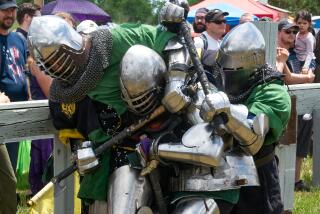Torrance Youth Finds Power in an Ancient Fighting Style
- Share via
TORRANCE — The spirit and martial arts of the ancient Japanese samurai are alive and well in a 17-year-old Torrance youth who will leave Monday for Paris to compete in an international tournament in kendo, the fighting style used by the feudal warriors.
Toyooki Sonoda, a Torrance High School senior, is among 12 Americans who will match their skills against kendo experts from about 20 countries, including his native Japan. The weeklong competition, sponsored by the International Kendo Assn., will determine the world champion of the Japanese version of fencing.
Sonoda, who has been practicing the stylized swordplay of the samurai since he was 9, earned his place on the American team by placing third in the U. S. competition in Seattle in January. Half of the team comes from Southern California, which has a large Japanese-American population.
Sonoda said he is the only team member from the South Bay, where he said kendo is gaining popularity among men of Japanese descent. He wishes that other nationalities would take up the sport because, he said, kendo would be good for them.
Instills Self-Discipline
In addition to getting participants into superb physical shape--kendo is one of the most grueling sports, Sonoda believes--the ancient fighting style instills strong self-discipline and respect for one’s peers and opponents in all aspects of life, he said.
The code of the samurai, as adapted to modern times, also promotes the confidence and determination needed to succeed in life, Sonoda said. He plans to continue practicing kendo as he develops his career in biochemistry.
For hundreds of years, beginning in the 12th Century, the samurai used their long swords, called shinai, in the service of Japanese feudal lords. The fighting style is characterized by swift, gliding steps and ritualized thrusts and swings of the sword in accordance with strict rules.
Unlike karate, kung fu and other forms of the martial arts, kendo does not rely on the hands and feet for defense or offense, and in the training version a bamboo sword is used. Points are scored by striking blows on the head, wrists or torso and by thrusts delivered against the throat area.
Some Are Killed
Contestants wear elaborate protective gear, but Sonoda said deaths have occurred in matches, though rarely. The skill of a kendo fighter, who trains in a studio called a dojo , is measured in ranks, beginning with a zero kyu and advancing after decades of rigorous and devoted practice to 10th dan .
Sonoda said he is a second dan , roughly the equivalent of a black belt in karate. As far as he knows, no one living today holds the rank of 10th dan .
People don’t go into kendo to defend themselves--for one thing, it wouldn’t be practical to carry a three-foot stick around all the time--but most karate and kung fu artists would have little chance against an expert kendo fighter, Sonoda said.
Kendo is much more than a sport, he said. “It’s a mental game, a way of living in the past with all the old traditions. I don’t understand all of it yet, but it’s really deep.”
Sonoda came to this country as an infant. His father, Yasuhiko, is in the textile business. He has two sisters--the younger, Hiroko, 14, also practices kendo.


